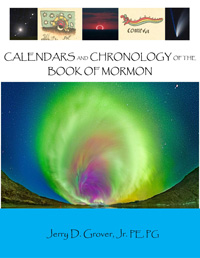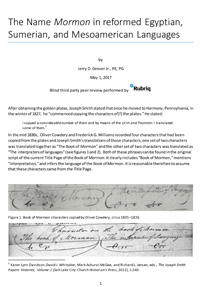


Jerry D. Grover, Jr.
Jerry D. Grover, Jr., is a licensed Professional Structural and Civil Engineer and a licensed Professional Geologist. He has an undergraduate degree in Geological Engineering from BYU and a Master's Degree in Civil Engineering from the University of Utah. He speaks Italian and Chinese and has worked as a freelance translator off and on for the past 25 years. He has provided geotechnical and civil engineering design for many private and public works projects. He took a 12-year hiatus from the sciences and served as a Utah County Commissioner from 1995 to 2007. He is currently employed as the site engineer for the remediation and redevelopment of the 1750-acre Geneva Steel site in Vineyard, Utah.
Jerry D. Grover, Jr., is a licensed Professional Structural and Civil Engineer and a licensed Professional Geologist. He has an undergraduate degree in Geological Engineering from BYU and a Master's Degree in Civil Engineering from the University of Utah. He speaks Italian and Chinese and has worked as a freelance translator off and on for the past 25 years. He has provided geotechnical and civil engineering design for many private and public works projects. He took a 12-year hiatus from the sciences and served as a Utah County Commissioner from 1995 to 2007. He is currently employed as the site engineer for the remediation and redevelopment of the 1750-acre Geneva Steel site in Vineyard, Utah.
-

Translation of the "Caractors" DocumentRevised and Updated
Mormon's Chronological Summary of the Period from the 19th Regnal Year of the Reign of Mosiah I to the Coming of the Limhites and Mormon's Synopsis of the Book of Mormon Prophetic Calendar.
A small scrap of paper entitled "Caractors" (also known as the Anthon Transcript) that contained reformed Egyptian characters copied from the plates from which the Book of Mormon has remained an enigma for more than a hundred years. The characters were successfully translated in 2015. This initial translation has been recently revised and updated, with additional supporting documentation. The number system found there is extensively analyzed and shows to preferentially use the Hebrew and Mesoamerican sacred numbers. Additional work shows that the time frame of the Egyptian hieratic identified there correlate to the correct time frame as the Book of Mormon. The author's approach is meticulous and scientific. This book is a landmark event in Book of Mormon studies and is a book that must be read by every serious student of the Book of Mormon and of Mesoamerican studies.
-

Calendars and Chronology of the Book of Mormon
Anyone that has read the entire Book of Mormon, whether believer or not, will note that the book is heavy in chronological structure, from the various prophecies fulfilled after a specific number of years, to the continuous mention of nearly every year in certain periods. While the calendars within the Book of Mormon are internally consistent, it has not been apparent as to how these calendars correlate to events in Israel and in Mesoamerica. The book provides proof of exact correlation of Book of Mormon calendars with the siege of Jerusalem, the break in the siege of Jerusalem, and the final destruction of Jerusalem. It also provides exact dates and correlation for the birth and death of Christ, consistent with known Biblical scholarship in Israel. It also shows a direct correlation to a known date in Mesoamerica. It also provides an internally consistent Jaredite calendar that also conforms to known scientific and archeological data found in the core Olmec area. Also identified is a new Jubilee Calendar.
-

The Swords of Shule
The Olmec civilization has long been considered to be the Jaredite civilization. New evidence is presented here that provides a reliable correlation of chronology between Mesoamerican archaeology and the Jaredite timeline. New etymological and scientific evidence now provides a method of establishing a more detailed geography of the "land northward" referred to throughout the Book of Mormon, the Old World point of departure of the Jaredites, and Olmec cultural elements reflected in the Book of Mormon text.
-

Evidence of the Nehor Religion in Mesoamerica
The prophecies of Abinadi in the Book of Mormon, his sacrificial death, and the deaths of his murderers all correlate with Maya rituals and ceremonies. The later order of Nehor, having common elements with the king Noah syncretic religion, also correlates with known Mesoamerican religious practices, one correlation being the Principal Bird Deity and its manifestations. Two other religious traditions, the "Great Spirit" and Amalekites, are derivatives of the Nephite religion.
-

Sumerian Roots of Jaredite-Derived Names and Terminology in the Book of Mormon
This book makes and demonstrates that Jaredite names and terminology and later Jaredite-derived names originate from ancient Sumerian. All unknown words in the Book of Mormon are evaluated and analyzed as to their original meanings. Also important is the demonstration that the Book of Mormon translation utilizes target source languages, and all transliterations are standardized to these languages.
This book shows the meaning in Sumerian compound words of all of the unknown words and glossed words in the Book of Mormon, as well as looking at all other Book of Mormon names. Also featured is an analysis of interpreted names and their significance on determining the language of the plate stack.
-

Geology of the Book of Mormon
Ever since the publication of the Book of Mormon, attempts have been made to place it in its geographical setting. Various geographical models are being debated. In a book that is the first of its kind, Jerry Grover, a professional civil engineer and geologist, utilizes geologic and geophysical analysis with clues in the Book of Mormon itself to provide an eye-opening placement of the Book of Mormon in its geologic setting. The book includes extensive details and a professional academic technical analysis of volcanoes, fault systems, meteorology, and unlike many approaches that cherry pick conveniently to fit preconceived ideas, the author takes on and explains and documents all Book of Mormon references to geology and meteorology. The authors approach is meticulous and scientific. This book is a landmark event in Book of Mormon studies and is a book that must be read by every serious student of the Book of Mormon.
-

Ziff, Magic Goggles, and Golden Plates
An analysis of the etymology of the unknown word "ziff" in the Book of Mormon and an analysis of the usage in a Mesoamerican context. Also included is a metallurgical analysis of the Book of Mormon plates as to dimensions and alloy content.
-

The Name Mormon in reformed Egyptian, Sumerian, and Mesoamerican Languages
In the mid 1830s, Oliver Cowdery and Frederick G. Williams recorded four characters that had been copied from the plates and Joseph Smith's translations of those characters. Egyptian translations of these glyphs have been deciphered. One of these glyphs, the name Mormon in the reformed Egyptian, is found in hieratic Egyptian with meaning matching the Book of Mormon prophet Mormon. The glyph (Lazy-S) is found in the ancient Olmec and Maya cultures concurrent with Book of Mormon time frames. The meanings and depictions associated with the Mesoamerican Lazy-S glyph are consistent with the etymological meanings for the phonetic word Mormon found in Egyptian and Sumerian. Book of Mormon descriptions associated with the geographical locations identified as Mormon are consistent with the Mesoamerican meaning of the Lazy-S glyph. The Mesoamerican Mormon glyph may have originated in Sumerian proto-cuneiform.
-

Possibilities of a Reformed-Egyptian Version of the Small Plates
There is evidence that the small plates included in the plate stack created by Mormon and Moroni and found by Joseph Smith were not the original small plates, but rather were a version that had been translated/interpreted into reformed Egyptian. This evidence includes the reported appearance of the plate stack by modern-day witnesses, the fact that Mormon and Moroni did not seem to prefer using reformed Egyptian, Book of Mormon figures' apparent lack of knowledge of prophecies recorded in the small plates, the presence of an interpreted term in the small plates section, the presence of a narrative voice, the textual consistency of the Book of Mormon, a general absence of reference to the small plates in the Book of Mormon, and the evidence that knowledge of Egyptian was lost at some point, which would have resulted in the necessity of using reformed Egyptian.



